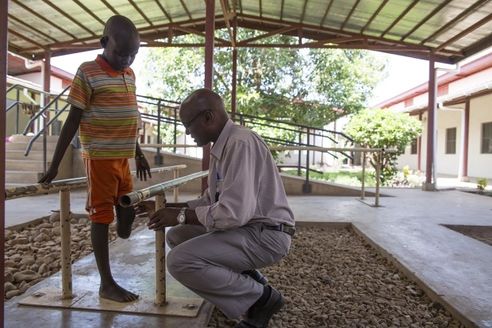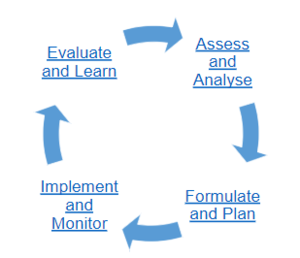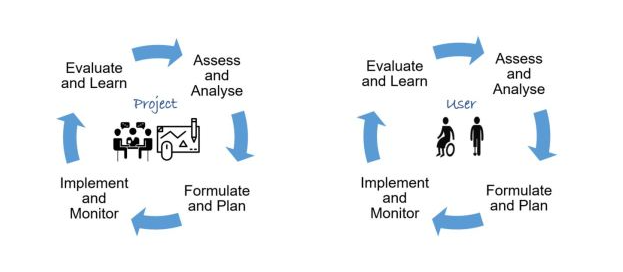Professional Standards in (ICRC) Physiotherapy
This article or area is currently under construction and may only be partially complete. Please come back soon to see the finished work! (31/05/2021)
Original Editor - ICRC uploaded by Kim Jackson
Top Contributors - Kim Jackson and Admin
Related Pages[edit | edit source]
- Professional Standards in (ICRC) Physiotherapy
- ICRC Physiotherapy Standards Project Cycle
- ICRC Physiotherapy Standards Rehab Cycle
Introduction[edit | edit source]
Physiotherapy is a worldwide profession that strives to provide rehabilitation to those in need. The multiyear project of PT standards development and implementation were initiated in 2014 by Barbara Rau with support of Prof Liz Holey and Anne Binks and numerous physiotherapy colleagues worldwide. Since 2017 the project is led by Cornelia Barth.
This project would have been impossible without the participation of rehabilitation teams and physiotherapy users contributing in numerous ways to its success. The documents on this page are the collective work of many valuable hands and minds.
The ICRC is committed to ensure that ‘the highest possible quality of care in line with appropriate standards' are integrated into all healthcare systems. To achieve this the ICRC has developed international standards, adapted to the humanitarian context, the ICRC 23 PT Standards explained (PTS). They aim to achieve a threshold standard of quality, as the first step in improving physiotherapy outcomes for service users in ICRC-supported projects[1], they include:
- Direct patient care
- Supervision
- Management and
- Teaching
The ICRC Physiotherapy Standards[edit | edit source]
The PTS are divided into two parts the project cycle and the rehab cycle. Both cycles are based on a system of:
- Assessment and analysis
- Formulate and Plan
- Implement and Monitor
- Evaluate and Learn
The standards consist of:
- User/Patient related - Respect, informed consent, confidentiality
- Procedures (rehab cycle) related - assessment, treatment planning, implementation, evaluation, discharge
- Therapist (service provider) related - Communication, lifelong learning, professional conduct, quality improvement
- Service Provision relation - data management, safety and security, Human Resources.
User/Patient Related (Service User)[edit | edit source]
- Standard 1 - Respect Recognition of the service user as an individual is central to physiotherapy and is demonstrated at all times
- Standard 2 - Informed Consent Service users are given relevant information about the proposed physiotherapy plan. This should take into account their age, gender, culture, emotional state and ability to understand, to allow informed consent to be given. The most appropriate format for informing the service user should be used
- Standard 3 - Confidentiality Information which the service user gives to the physiotherapist is treated in the strictest confidence by the physiotherapist
Therapist Related (Service Provider)[edit | edit source]
- Standard 4 MDT Assessment Information is gathered from a variety of sources in order to determine the service user’s health status
- Standard 5 Analysis and Treatment Planning Following information gathering and assessment, analysis and clinical decision-making is undertaken in order to formulate a treatment plan
- Standard 6 Implementation The treatment is adapted to meet the service user’s individual needs and delivered in a way that benefits the service user. Where applicable, this should be done within a MDT context
- Standard 7 Evaluation The service user’s physiotherapeutic progress is reviewed when possible
- Standard 8 Evaluation The service user’s response to physiotherapy is measured using a service user focused outcome measure
- Standard 9 Transfer / Discharge On completion of the treatment arrangements are made, with the MDT, for the transfer of care or discharge
- Standard 10 Communication The physiotherapist communicates effectively with service users and/or their carers/relatives
- Standard 11 Communication The physiotherapist communicates effectively with the MDT and other relevant professionals to provide an effective and efficient service to the service user
- Standard 18 Human Resources Each member of the team should have clearly defined roles and expectations
- Standard 19 Lifelong Learning The physiotherapist assesses, plans, implements and evaluates his/her formal and informal lifelong learning
- Standard 20 Professional Conduct The physiotherapist demonstrates ethical and professional conduct, and compliance with guidelines and regulations
- Standard 21 Quality Improvement The physiotherapist demonstrates commitment to and contributes to improving the quality of service user services, to improve the health of service users
- Standard 22 The physiotherapist encourages and responds to service user feedback
- Standard 23 Physiotherapy is based on review of the best available evidence
Service Provision (Service) - Standards 12 -[edit | edit source]
- Standard 12 Data Management To facilitate service user management and satisfy legal requirements, every service user who receives physiotherapy must have a record
- Standard 13 Data Management Service user records are retained in accordance with existing policies
- Standard 14 Data Management Relevant information is recorded, collated and reported to stakeholders as required Explanation There is clear reporting as required
Service User, Therapist and Service Related[edit | edit source]
- Standard 15 Physical Environment and Safety of the Service User and Physiotherapist The physical set up of the clinic must have adequate spaces and therapeutic equipment that enables physiotherapists to deliver physiotherapy services across the full scope of practise of the service
- Standard 16 Physical Environment and Safety of the Service User and Physiotherapist Service users are treated in a clinical environment that is safe for service users, physiotherapists and carers
- Standard 17 Physical Environment and Safety of the Service User and Physiotherapist All equipment is safe, fit for purpose and ensures service user, carer and physiotherapist safety
Standards for Project cycle vs Rehab cycle [edit | edit source]
There are 23 ICRC Physiotherapy standards in total, accompanying the various sequences of the Result Based Management (RBM).
A number of the standards are related to projects, others are related to a rehab cycle.
Resources[edit | edit source]
References[edit | edit source]
- ↑ Holey L; Rau B From fragile to sustained physiotherapy practice: improving quality of care and patient outcomes through enhanced standards of practice. [Internet] February 2018. [Accessed 18 February 2021] Available from https://odihpn.org/blog/fragile-sustained-physiotherapy-practice-improving-quality-care-patient-outcomes-enhanced-standards-practice/









